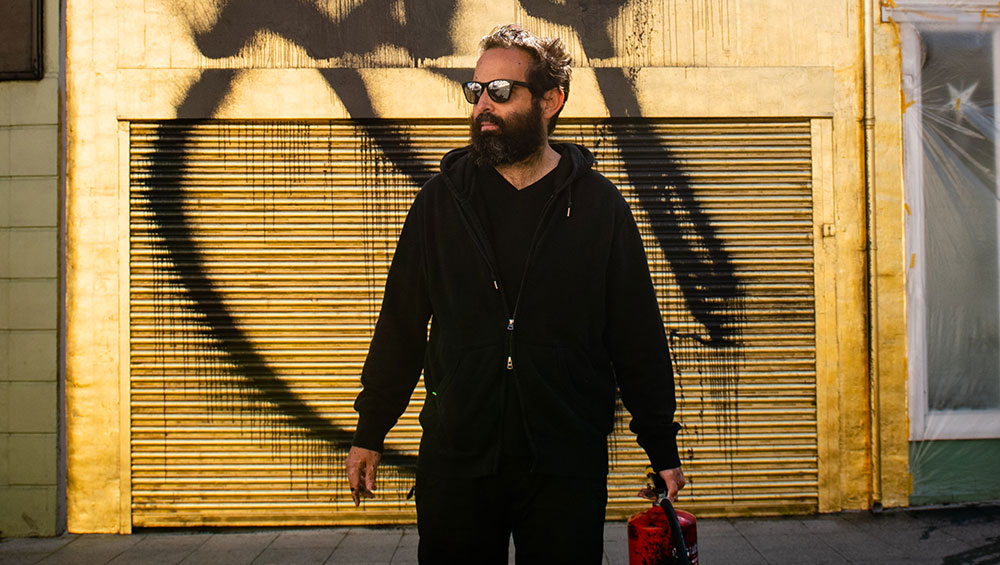
Stefan Brüggemann, OK (Untitled Action), 2020. Photo: John Nguyen/PA.
by VERONICA SIMPSON
Gold has topped and tailed the lockdown experience for artist Stefan Brüggemann (b1975, Mexico), but in two contexts and presentations that could hardly be more diverse. In late May, as the UK approached the last of its three months of lockdown, he used a fine gold-leaf spray to cover the entire facade of a three-storey office and shopfront in the scruffy coastal town of Folkestone. His intervention gleams among the dusty, shuttered shops in what was once a thriving trading and ferry port, but is now reliant on the imported vitality of its sizeable artist population, who have abandoned the hostile pricing of London for cheap studio space, housing and a vibrant cultural scene.
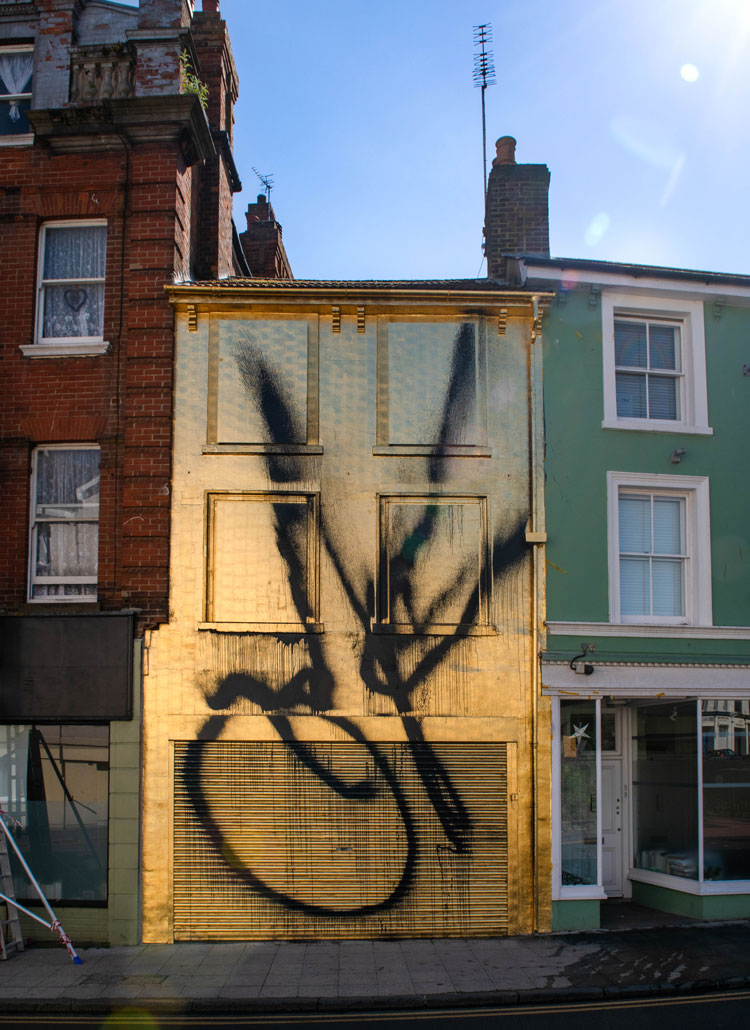
Stefan Brüggemann, OK (Untitled Action), 2020. Photo: John Nguyen/PA.
A good deal of Folkestone’s cultural success is due to the generosity of its resident benefactor, businessman Roger de Haan, originator and founding funder of the Creative Quarter and the Folkestone Triennial. However, Brüggemann’s gilded offering is nothing to do with the Triennial, which was due for its next outing this autumn, but has been postponed to 2021. The building Brüggemann uses as his canvas belongs to the not-for-profit agency Hop Projects, which provides support, exhibition and studio space to local artists and invited Brüggemann to contribute a work this year.
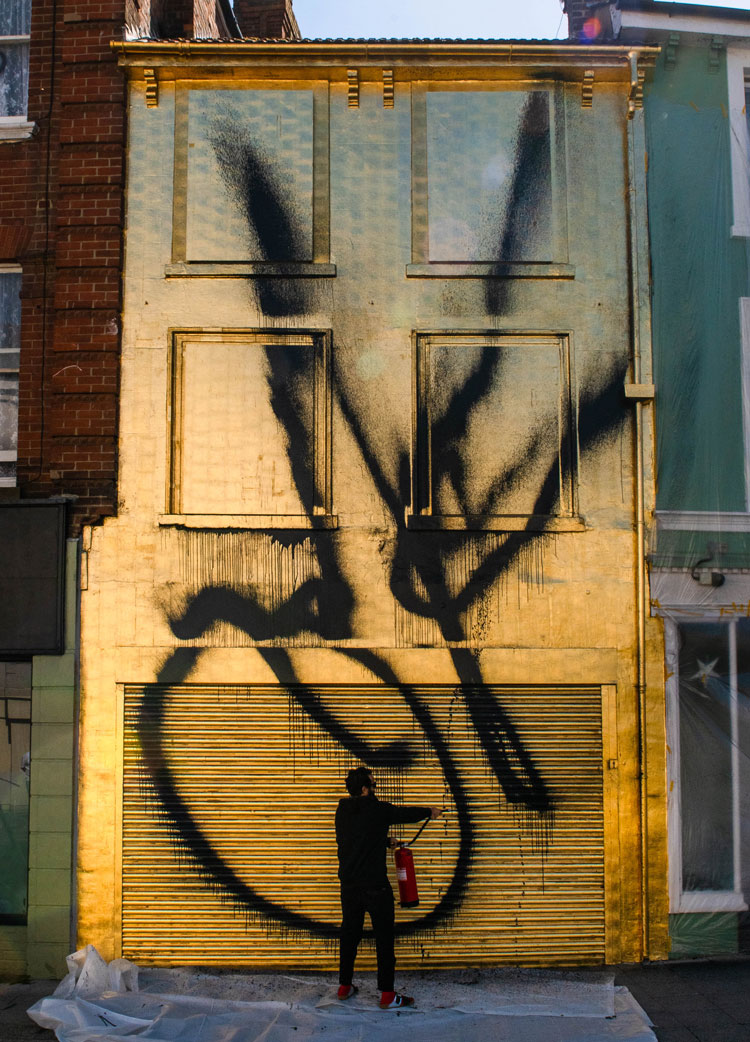
Stefan Brüggemann, OK (Untitled Action), 2020. Photo: John Nguyen/PA.
For one of the south east’s poorest towns – even before the Covid-19 pandemic took its economic toll - the quantity of gold leaf used to create OK (untitled action) across the exterior of this local arts HQ could be seen, on the one hand, as a celebration of humanity and creativity at a time when both are in dire need and, on the other, as an affront to the town’s dispossessed, diverting funds that could be better placed elsewhere. Brüggemann is fine with ambiguity. That is one of the reasons he has spray-painted the word OK across this gold facade, in a dripping, black handwritten scrawl – a word that can be positive, negative or neutral, depending on context. What he wants is for his work to provoke curiosity, reflection and, over time, a shifting of perspectives.
Meanwhile, in July, an exhibition of gold paintings will be unveiled in Hauser & Wirth’s St Moritz gallery, emerging from a lockdown period of seemingly concentrated production, in his London studio.
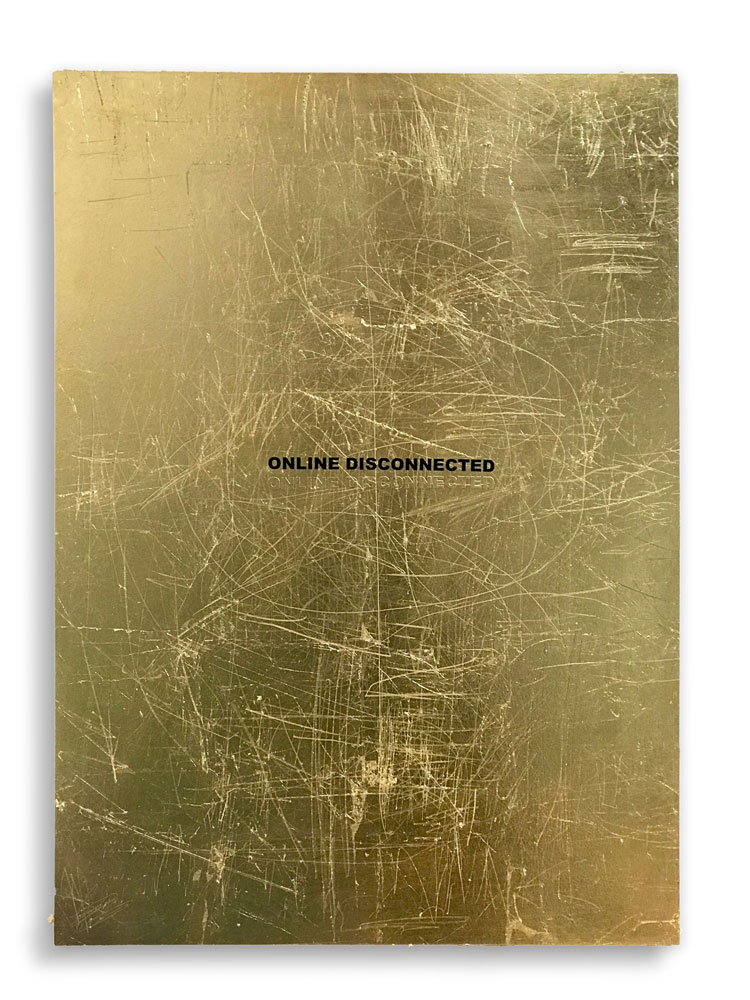
Stefan Brüggemann. Online Disconnected (Hyper-Poem Lockdown), 2020. Gold leaf and vinyl text on wood, 70 x 50 cm (27 1/2 x 19 5/8 in). © Stefan Brüggemann. Courtesy the artist and Hauser & Wirth.
Evolving from his previous Text Pieces, these paintings combine the richness and symbolism of gold – a precious material since time immemorial – with phrases that draw from the current, digital age not just for content but also in their brevity, rhythm and seeming spontaneity. He presents these as “shortened modern poems”. Slogans and soundbites jostle for legibility across surfaces that are reminiscent of Jenny Holzer’s silver and gold Redaction Paintings – except, here, it is what is added that brings significance, not what has been removed.
The mess and noise of digital conversation are very much at the core of Brüggemann’s current interests. For his 2019 Hauser & Wirth London show Hyper-Palimpsest, he opened with a black room, which he described as “a black hole that sucks all the matter of the world inside”, with subsequent rooms offering works where words and phrases were layered to the point of incomprehension.
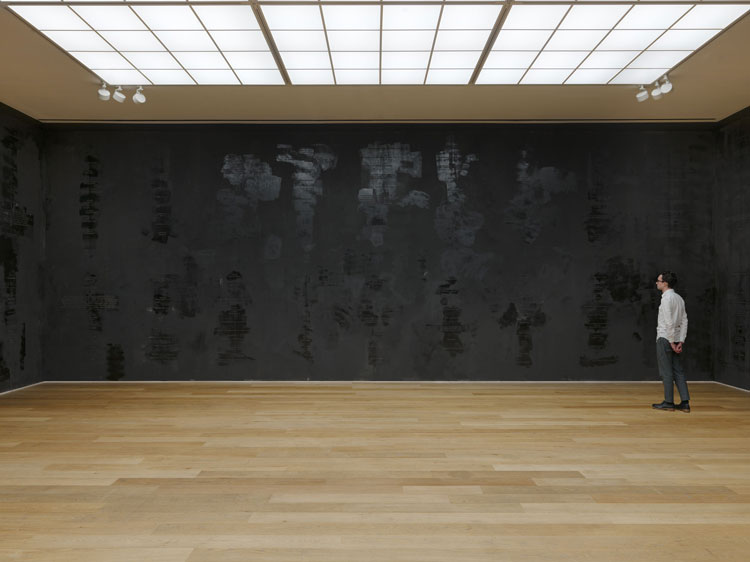
Stefan Brüggemann. HYPER – PALIMPSEST, installation view, Hauser & Wirth London, 2019. Photo: Todd-White Art Photography.
He told the gallery’s inhouse magazine, Ursula: “We’re a control-copy, control-paste society. Everybody is appropriating constantly. That’s part of our nature now.” He is also happy to take his work out into the streets: in 2014, he showcased Headlines and Last Lines in the Movies, at the Contemporary Art Gallery, Vancouver, boarding up the facade of the building with plywood and then writing multitudes of the aforementioned headlines and last lines across it in red or black. He also revisited that theme with a site-specific installation at the Pompidou Centre in 2019.
Brüggemann studied at Mexico City’s Centro Nacional de las Artes (CNA) after which he opened a shared art space together with Edgar Orlaineta in 1996, called Art Deposit. When that space closed in 1998, he came to London, but returned three years later to open Programa, another exhibition space showcasing international artists and supporting a more ambitious and experimental curatorial programme than could then be found in Mexico. He is represented by Hauser & Wirth and operates between London and Mexico City.
Veronica Simpson: I visited your work in Folkestone at the weekend, and it really stands out against the (currently) closed shopfronts that surround it. When and how did this project start taking shape?
Stefan Brüggemann: I had been discussing doing a project with Hop Projects for a year. I was going to do something different. I had several ideas. When lockdown started and things had to close, I had to crystallise what I wanted to do quickly. Everything was a lot more complex in lockdown. It was this situation that made me take the decision to work with the facade of the building.
VS: It is often part of your practice to take your work outside, as with your Vancouver Headlines and Last Lines at the Movies exhibition.
SB: I’ve done several interventions with exteriors but, for those, I worked with spray paint and for this work with gold leaf. In the end, it feels part of the same conversation. But I find it quite interesting at this time, with museums and galleries closed, to question how we can make public art work. And for me, the writing saying OK, opened lots of questions. It was an open-ended proclamation or protest.
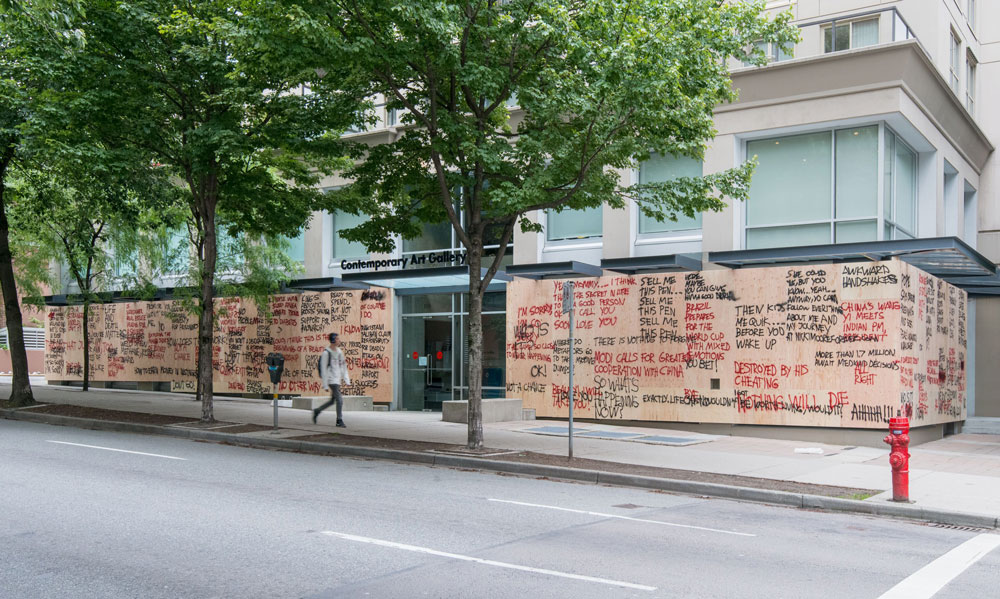
Stefan Brüggemann. Headlines & Last Lines in the Movies, installation view, Contemporary Art Gallery, Vancouver, Canada, 2014.
VS: Folkestone is a really interesting town, with various diverse communities, a lot of poverty and creativity, along with the conflicts that arise from this ongoing programme of culturally led gentrification.
SB: The issues of Folkestone are not unique. And I think the work adapts to all the different sociological contexts. It also speaks to other moments. When the work was first unveiled, the UK was still very much in the narrative of lockdown and … the coronavirus and all the polemic. The next week, we had the assassination of George Floyd in the US and huge protests for black rights and that word – OK - is still relevant, as a question, a challenge. The language in the work adapts to the consciousness of the public. In that sense, it maintains its vitality and resonance, depending on the context.
VS: I thought the gold leaf might be a reference to the Japanese art of kintsugi, in which a ceramic vessel or object is repaired with its cracks highlighted in lacquer and gold leaf, articulating different ideas around value. For those who might say Folkestone was “broken” – and is in the process of “fixing” itself - this gold leaf wrapping, and its placement, is very eloquent.
SB: What I like about using the gold leaf specifically is because it reveals the surface where it’s applied. It is very sensitive to light, to texture. Instead of covering things it reveals things. And, metaphorically speaking, it’s like revealing the sociopolitical moment we’re living in. Instead of hiding it, when you apply it on a surface, every little crack or whatever imperfections are in the wall, is revealed - far more than if you paint it white or black. That’s why I like gold leaf, for this idea of revealing. Having spray paint on top is like a contradiction. Normally, when you see spray writing, it’s always a complaint or dissatisfaction. Here, it becomes ironic. It makes you think about why it says OK. It’s not preaching and saying this is wrong, this is right; it’s more of an existential question.

Stefan Brüggemann, OK (Untitled Action), 2020. Photo: John Nguyen/PA.
VS: The building you chose is significant, however, in that it is the Hop Projects base.
SB: It does exhibitions inside and has artists in residence. That was also something I like. Small institutions have that flexibility to act under the circumstances of a lockdown. If I had been commissioned to do this at the Tate, it would have been impossible because of the policies and procedures it has. I like this flexibility.
VS: What sort of reaction has the work had locally?
SB: People are happy. People sometimes don’t understand if the word OK was commissioned or somebody just came and put it up, as graffiti. They understand that gilding the building was part of the project, and local people saw that it took a lot of time to do the whole facade. There have been mixed comments. But most of them are positive.
VS: There are several brightly coloured buildings around Folkestone, but this one really stands out.
SB: It makes it a high contrast, it’s more dramatic. It has an element of transgression, no? It’s more transgressive than if it was just a white facade. I like to play with those values. One interpretation is that the gold is very establishment, and the spray writing is very low cost and more spontaneous … more aggressive.
VS: Given that you often work in the street, and appropriate the art of the street, does your work ever get vandalised? For example, the hoardings you wrote on outside the gallery in Vancouver?
SB: We were surprised. There is no graffiti in that part of Vancouver. It’s not an area that you normally see spray writing around. It’s a very clean, urban area.
VS: There is such a lot of interest in street art and graffiti now. Are you interested in the evolution of that very public “art” arena?
SB: No, I’ve never been interested in that. I have always been more interested in spray writing, spray paint and protests. Graffiti is more like graphic design, there’s no real message, just a design. Street art for me… public sculpture is also street art in the end. For me, what people recognise as street art is also like pure design, decoration.
VS: As well as pursuing your career as an artist, you have been a curator and had your own studio and exhibition space in Mexico City.
SB: Yes. But it was not a gallery, it was a non-profit space. I was trying to build an institution for contemporary art. We had grants, we did fund-raising to have this big space, with studio space, but it was never a commercial gallery. We just did projects.
VS: What were you looking to facilitate in this space that was not on offer at that time?
SB: The era of contemporary art in Mexico, in the late 1990s, was still not very in tune with what was happening in the world. You had all these museums of modern art and contemporary art, very focused on Latin America and it felt like something was missing. That’s why I decided to open this space and invite artists from around the world to collaborate. It’s good because in your formative years it’s a way to interact with artists and you’re curious to understand their practice and be more part of the equation, part of the cultural landscape. It brought some international perspective. Now, the situation is different. Now, there are several museums with contemporary programmes and more commercial galleries.
VS: What did you learn through that experience?
SB: You learn every time you do an exhibition. It informs you about your practice. You reflect on it. For me it was very revealing to establish dialogues with people whose practice I was interested in. And it’s like a greenhouse: you plant seeds and then the ideas and the experimentation and the conversations grow.
VS: London used to have many spaces like that, but that has changed.
SB: That’s why I was curious to work in Folkestone. I liked the idea of the non-profit organisation. When I came to London in 1998, there were more artist-run and independent spaces and a lot of creativity. Now, there’s more commercial galleries and big institutions. In the late 90s, artists were putting on their own shows, like Damien Hirst.
VS: The artist-run spaces seem to foster a great atmosphere for experimentation across disciplines. We now see major galleries trying to generate dialogue and engagement with multidisciplinary performances, events and late nights. But the feeling isn’t that the artists are being inspired – it seems mainly to be about creating spectacle for the public and generating income from shops and bars. What do you think?
SB: Sometimes, when it’s too corporate, it loses the edge. I’m not against the Tate, or what it is doing. It’s very good what it has achieved. But you cannot have everything under the same umbrella. It’s like in business when people are looking for consolidation. They buy the whole food chain, then it makes industry and profit the focus, and it becomes boring.
VS: But the last decade has seen an exodus of London artists heading off to the coast, to the countryside and creating their own experimental communities. Can work in that context have the same impact?
SB: That depends on the quality of work you do. It’s not because you’re a non-profit (that the work is interesting). It all depends on what you’re delivering, what you’re saying.
Every circumstance has its advantage or disadvantage. Great projects can happen in Iceland and New York. And bad projects. Sometimes it’s the circumstances of having a certain amount of people with an energy and ideas, and that’s when good things can happen.
VS: In all the conversations around the coronavirus pandemic, I keep hearing artists – writers and musicians, too – saying that the best art comes out of a crisis. What’s your view on that?
SB: I think out of all crises, good things come. After the war, there was great art also, and after various economic crises. A moment of crisis is good for a change of perspective. When life is too comfortable, then people become apathetic. Crisis is not the perfect recipe: I wouldn’t recommend it. But that’s when your immune system has to come out to defend you.
VS: Have you found this lockdown period productive?
SB: Yes, very creative, very prolific. It changes because you’re absorbing what’s happening outside, the world is in a very unstable situation. Obviously, you have sorrow for all that, and then things come out of that. Every day that I can do my art, for me, is a privilege. I don’t want to miss one day. For me, any circumstance when I wake up with a lot of hope and wanting to do something is a good day.
Even more so perhaps in these circumstances: it’s like maybe it could be the last week I could do an artwork. I could get the virus and be dead in two weeks. You value that you’re alive. And that’s also why the Folkestone project came about. We said: “Let’s do it now before the world ends.”
VS: And now you have your first post-lockdown show opening, in St Moritz. What will be different this time?
SB: We’re not going to have an opening from 6-9. The doors will open in the morning and then stay open. There’s not going to be a specific celebration. I will be around sometimes. I like that format instead of lots of people at an opening. When you have an opening, you can’t see the work. I’m not a big fan of them. I’ve been to so many openings that you don’t even remember what you see because there are so many people in front of the work.
VS: I was chatting with Bedwyr Williams once and he said he thought artists are introverts with exhibitionist tendencies.
SB: Yes, I would agree we are full of contradictions. That’s our nature. But I prefer 10 people looking at the show properly, rather than having a room filled with 2,000.
• OK (untitled action) will remain at Hop Projects HQ in Folkestone for three years.
Stefan Brüggemann: Untitled Action (gold paintings) is at Hauser & Wirth St Moritz from 11 July to 30 August 2020.